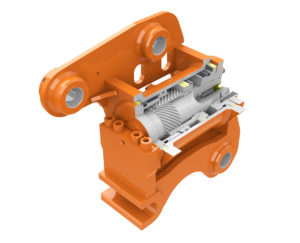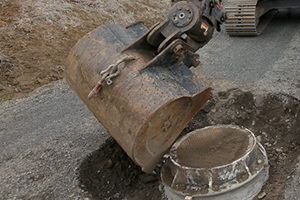
With PowerTilt’s 180° side-to-side tilt, and versatility, Clap can operate his Hitachi with precision, cutting all the slopes and angles with just one machine and without having to move it several times during the day.
Ray Clapp, owner of Coast Range Construction, Homer, Alaska, was searching for a way to increase efficiency on job sites. Coast Range specializes in setting foundations for lodges and cabins as well as performing house-site development for contractors. Homer has very little flat ground to build on. Terrain ranges from sea level up to 1,400 feet in elevation, and drainage issues are quite common.
On many job sites, it is difficult to maneuver machinery, particularly in tight spaces. Machines often need to be moved several times during a job which can extend the time of a project. Additionally, the challenging terrain is often only accessible by water. The equipment has to be transported by barge. To differentiate himself from the competition, Clapp needed a tool that could easily work in tight spaces so that the work could be done cleaner and faster.
Clapp ultimately purchased the PowerTilt tilting coupler and added it to his Hitachi ZX200LC. With PowerTilt’s 180° side-to-side tilt and versatility, he can operate his Hitachi with precision, cutting all the slopes and angles with just one machine and without having to move it several times during the day.
Inside Parker Helac’s rotary actuator technology
PowerTilt uses a sliding-spline operating technology to convert linear piston motion into shaft rotation. Each actuator is composed of a housing and two moving parts – the central shaft and piston. As hydraulic pressure is applied, the piston is displaced axially, while the helical gearing on the piston OD and housing’s ring gear cause the simultaneous rotation of the piston. PowerTilt’s end caps, seals and bearings all work in tandem to keep debris and other contaminants out of the inner workings of the actuator, prolonging product life and reducing required maintenance.

Whether Coast Range is creating a drainage system for a commercial or residential site or digging out dirt for a septic system the PowerTilt can easily work on cutting through slopes and swales without moving the machine several times. With the 180° rotation on the PowerTilt they are able to slope and grade the site with one machine.
Applications
The PowerTilt can be used with a variety of attachments. Coast Range mainly uses it for grading projects but some projects have seen the need to attach standard or narrow buckets.
- Drainage site work: Whether Coast Range is creating a drainage system for a commercial or residential site or digging out dirt for a septic system the PowerTilt can make the finished look impressive.
- Site development: They can easily work on cutting through slopes and swales without moving the machine several times. With the 180° rotation on the PowerTilt, they are able to slope and grade the site with one machine.
- Dock building: The PowerTilt is used as a pile driver to push the pilings of the dock down into the ground under the water. Ray will tilt the PowerTilt at an angle to be able to drive the piling into the ground better.
- Rock: The River Teeth attachment with the PowerTilt helps Coast Range rip through rocks in the soil. They can position the PowerTilt at an angle to rip rocks out on a slope or ditch.
Increased productivity and equipment inventory reduction
Coast Range used to require three machines for any given project: the Hitachi excavator, a track loader and a small dozer. By adding the PowerTilt to his excavator, projects were completed one to two days faster. The small dozer was only being used an average of 90 hours a year where most machines average about 2,000 hours a year. Clapp estimates a 30 percent increase in productivity with the use of this tool. He also decided to eliminate the small dozer, and now saves one-third of the time to complete the same work he used to do with the small dozer. Reduction in equipment decreases transportation costs too.
Purchasing the PowerTilt has given Ray an advantage over the competitors in the area by increasing productivity and creating a clean and more precise finished look on the job site. In using this tool for the past 10 years he has had no maintenance issues or downtime.
Reliability and durability
The PowerTilt is reliable. The PowerTilt has outlasted Clapp’s machinery. Regular scheduled maintenance and greasing have been key but ten years later, Coast Range’s current PowerTilt has up to 8,000 hours on it and is still going strong with no maintenance issues. Clapp has a lot of confidence that the PowerTilt will always finish the job in any type of weather, terrain or environment in Alaska.
PowerTilt is available for equipment up to 75,000-lbs in eight sizes with the standard rotation of up to 180°. Each model is designed for a specific class of machinery and individually customized to fit the carrier.
Parker Hannifin
www.parker.com
Filed Under: Mobile Hydraulic Tips